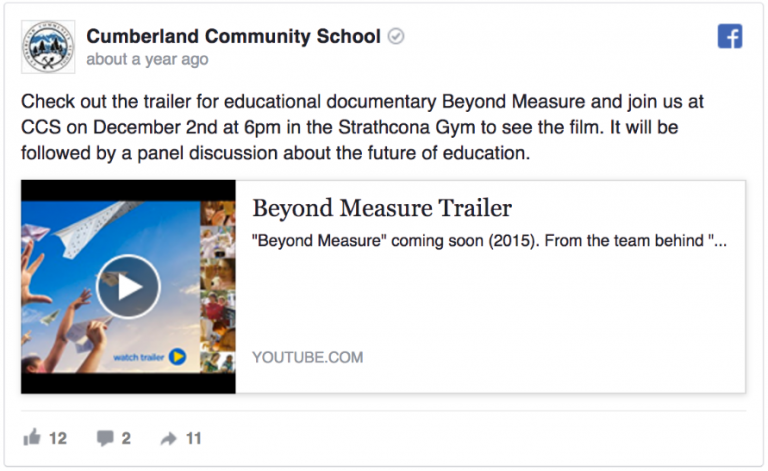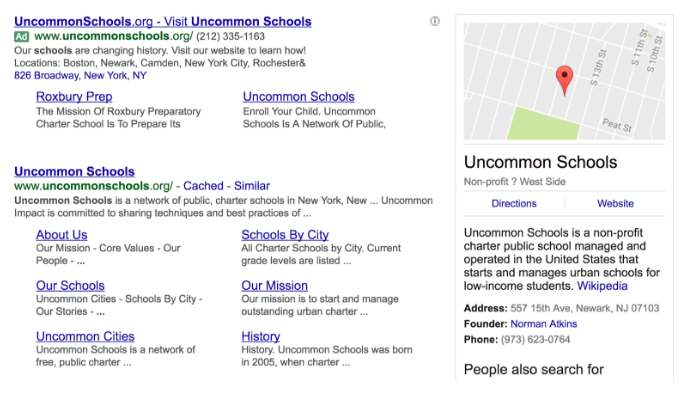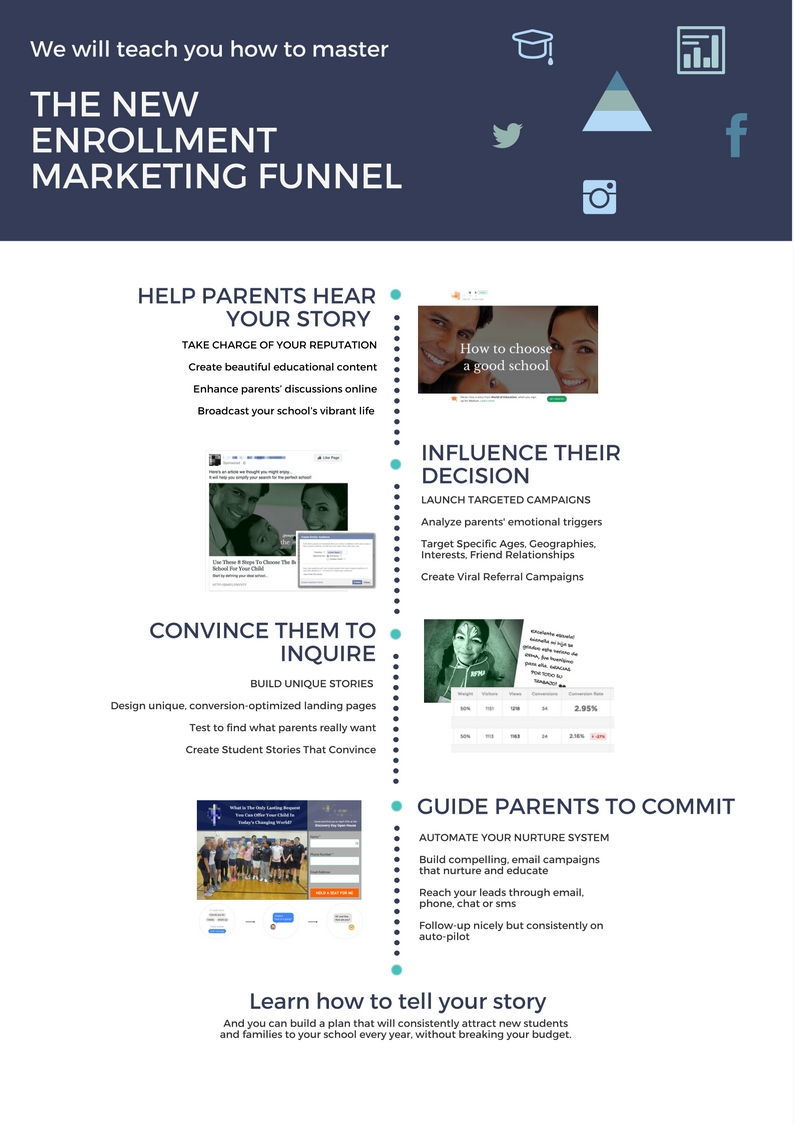The Beginner’s Guide to Social Media Marketing for Schools
We have some good news.
You can finally start feeling in control of your enrollment.
School leaders always have this little nagging feeling. Whether student numbers are trending up or down…
…what will the number be next year? Who knows?
Well, now you can.
You don’t have to watch helplessly as your enrollment numbers rollercoaster year after year. Social media marketing can provide consistent, predictable enrollment figures.
Perhaps you’re not that familiar with online and social media marketing, and formulating a campaign might seem like an insurmountable challenge.
It doesn’t have to be. And this guide really can help.
Building Your Enrollment Marketing Funnel
Before we get too far into this discussion, it will help to define what an enrollment marketing funnel is.
It’s not that complicated.
Essentially, it’s just a series of steps which guide parents through the process of becoming familiar with your school. Ideally, it ends with them enrolling their children in your fine establishment!
It’s important to keep on remembering who you’re marketing to. Parents are the ones that will be researching your school and casting a critical eye over your academic and extracurricular programs. They’re the decision makers.
Parents quite literally shop around for schools and make decisions based on a range of criteria, including:
Current School Stats: These are crucial considerations, and include educational outcomes, college acceptance rates, teacher turnover, the teacher-to-student ratio and more.
School Facilities: How old are your facilities? What condition are they in? Do they cater for a wide range of activities?
Reputation: What’s your school’s reputation? Do you provide quality education in a disciplined environment? Are you known for preparing future business leaders? Do you have a direct connection with local employers and keep your finger on the pulse of employment trends?
Proximity: How close are parents to your school? Do you facilitate student transport? Most parents are unwilling to send their children more than 10 to 25 miles away from home, and this is something you need to consider.
After School Programs: Parents are very interested in what you have to offer in the way of after-school programs that boost performance in arts, athletics, languages and various other academic and sports disciplines.
Why does your school need a marketing funnel? Well, are your enrollments and parent interest at levels you’re happy with? If yes, understand that this won’t last forever in this ever-changing environment. If no, well then there is definitely room for improvement.
You need an enrollment marketing funnel to tell parents your story, to get them excited about your school, and to influence their decision about where to send their children.
An enrollment marketing funnel doesn’t need to be overly complex. In fact, it can be relatively simple. There’s the top of the funnel, or TOFU (the widest portion, and the first parents will encounter).
Then, there’s the middle of the funnel (MOFU), which narrows and guides prospective parents deeper.
Finally, there’s the bottom of the funnel (BOFU), which narrows further and should encourage parents to move from consideration to enrollment.
Your marketing funnel should:
- Help parents hear your story
- Influence their decision
- Convince them to inquire
- Guide parents to commit
That’s it. Well, almost. There’s more to it, which we explain fully below.
TOFU: Help Parents Hear Your Story
Your school’s unique story is the crucial first step at the top of your enrollment funnel. You need to tell it in ways that encourage parents to hear, interact, and share.
It’s all about building awareness and sharing your story.
Social media is an ideal way to achieve that. Here are some examples of real schools putting their stories out there in an engaging, enticing way:

In the example above, the school does a couple of important things.
First, they create a short, compelling narrative that entices parents to check out the linked video. They connect directly to parental concerns, like the future of education.
And, because they’re using Facebook, the video is playable within the post, so parents don’t have to leave the page. It streams right in their feed.

In this second example, parents are enticed to check out the 20 best public high schools in Texas.
That ties directly in with parents’ desire for their children to experience a quality education, and while clicking the link will take them to another website, the headline promises to deliver important information.

In this final example, you’re presented with a group of smiling children and an engaged teacher in the image.
The copy promises to help parents with their choice of private school by identifying key benefits of a Catholic education. Based on those benefits, parents would be able to compare their options and make a more informed decision.
MOFU: Influence Their Decision
It’s not enough to tell your story. You need to give parents information, visuals, and stories that will help influence their decision (in your favor, of course), and this is done in the middle of the funnel.
Here, parents have opted to engage with you, they’re familiar with you, and they are actively considering your school.

In the example above, parents have their decision influenced in a couple of ways.
Obviously, the use of the word “tuition-free” is a prime example. However, there’s also the promise that the article ranks the top handful of schools in the area, as well as the statement that “All Denver kids deserve a high-quality education”.

Here’s another excellent example. This one is taken from a simple Google search for “private middle schools”.
Google automatically sorts your results based on geographic area and puts paid ads (AdWords, which we’ll talk about shortly) at the top of the search results.
So, any parent searching for private middle schools in the Lake Mary, Florida area, would immediately see the two ads for specific schools, just above links to rating and ranking sites.

Here’s another example, and this one does a great job of influencing parental decisions without much copy.
It’s all about the image being shared. What do you see?
Diversity? Yep.
Fun? Sure.
Friendship? Absolutely.
A deep connection between students? Definitely.
This image manages to convey all those things without using any text at all, tying into a parent’s desire for their children to build friendships, to enjoy themselves, and still enjoy a first-class education.
BOFU: Convince Them to Inquire
So far, you’ve told your story, and you’ve influenced parents’ decisions, but that’s not the end of the enrollment funnel.
You still need to convince them to check into your school. This occurs at the bottom of your funnel.
This is where parents act, moving from considering your school to enrolling their child.

In the example above, you see an excellent way to entice parents to inquire. In fact, it’s an invitation to visit in person.
Not only does the school encourage parents to visit their open house, but they tie into the parental desire to build on their child’s unique talents in a “caring and disciplined environment”.
Of course, the fact that this is a Facebook event also has significant power. Parents can mark themselves as interested, attending, or unable to attend, and they’ll also see friends and other connections who respond to the post.

This example doesn’t revolve around social media, but it does highlight the need to have a well-organized website with clearly identified pages and immediate access to crucial contact information.
Post Opt-In Nurturing: Guiding Parents to Commit
Social media marketing isn’t about quick sales (or immediate enrollments, in this case). It’s about building relationships.
Once parents opt into your marketing campaign, it’s your job to guide them from inquiry to enrollment. You need carefully considered and tailored content to do this.
Should you answer questions? Yes.
Should you provide insight into your school’s performance and success? Absolutely.
Do you need to highlight student achievement? Yes.
Should you provide educational information to help parents better understand how your school stands out from others? You bet.
All of these are crucial considerations for inclusion in your post opt-in nurturing efforts. You build that relationship, guide parents through the funnel, and, ultimately, see them enroll their children in your school.
What Else Do You Need to Do?
We’ve highlighted several crucial steps, but these are just the tip of the proverbial iceberg. There’s more that must be done.
Let’s start with developing an ideal parent profile – who are the ideal parents of students that would fit in your school?
To create an ideal parent profile, you’ll need the answers to some important questions, including the following:
What’s the Job Market Like? You need to speak to the prominent industries and professionals in your area. Get to understand who you’re speaking to in your marketing efforts, this will ensure your message is relatable.
What’s the Median Income? To design and develop courses sensitive to parents’ financial circumstances, you need to know more about the area’s median income and other socioeconomic factors.
How Is the Population Changing? Population trends in your area will dramatically impact enrollment. Know the projected changes for a year down the road, 10 years in the future, so that you can tailor your recruitment methods.
Are You Familiar With Current Demographics? Your ability to address your school’s needs and challenges hinges directly on understanding the ethnic, gender and racial demographics of your community.
By exploring these topics, you can arrive at many other answers.
There are small little touches too, such as the fact that you might be best served by engaging with your audience in the mid-morning, not the afternoon.
You might find that there are thousands of parents in your area interested in schools just like yours but who don’t have access to information.
You could discover that one neighborhood is an excellent target, while some others wouldn’t suit your offerings.
Next up, you’ll need to decide on the type of funnel you’ll be using. There are several options, including:
Open House: We saw an example of this previously, with parents being invited to your school. This is extremely relatable and effective on social media.
Lottery: Lotteries can be beneficial, drive demand, and increase the sense of scarcity.
Lead Magnets: Lead magnets offer valuable information and entice parents to learn more or directly act on their interest.
One-Time Offers: One-time offers encourage quick decisions and can be used to move parents from the consideration stage to the enrollment stage.
Webinars: Webinars offer the ability to share information, as well as answer questions from parents.
Parent Referral Campaigns: These campaigns can be very valuable tools, particularly if you offer a discount for both parties on next year’s tuition.
PPC for TOFU
PPC, or pay-per-click advertising, has become pretty widespread today, and you have many options. These programs can be valuable tools for use at the top of your enrollment funnel.
There are three primary options today: Twitter, Facebook, and Google AdWords.
Twitter: Twitter can be used by schools to connect with parents in their area, but it’s quite limiting, particularly in the amount of copy allowed.
You’ll also find that the ROI isn’t quite as good as you would expect.
Facebook: Facebook is the leader in PPC (and social media marketing in general). You get massive reach, outstanding tools to focus your marketing toward a specific audience, and great diagnostic and analytical tools.
The ROI with Facebook can be quite good (provided you’re savvy with your marketing efforts).
AdWords: The granddaddy of all PPC programs, AdWords can be a useful tool. You’ll remember those ads from one of the previous examples we used.
AdWords can deliver good ROI. However, they don’t have quite the same reach as Facebook ads due to a number of factors, including the widespread adoption and use of Facebook.
AdWords ads are only displayed to those searchers using targeted keywords, which is a bit limiting.
Use a Targeted Landing Page
You cannot simply redirect from a PPC ad to your website’s homepage. If you do, you’ll be missing out on offering a targeted follow-up message to interested parties, as well as the ability to directly track follow-ups.
Instead, you need a targeted landing page that ties directly in with the language of the ad in question (and you need a landing page per campaign, per platform). Using these tools, you can track your visitors properly. You can learn where they came from, the pages on your site they clicked after visiting the landing page, and much more.
All of that information can then be used to tailor your marketing campaigns, offers, and the overall enrollment funnel.
Reselling and Retargeting
Don’t think your ads only serve a single purpose. Reselling and retargeting can enhance value and ROI.
Essentially, this is nothing more than serving PPC ads to people who’ve already visited your website through other sites.
Say a parent visited your school’s website, browsed about a bit, and then returned to Facebook. He or she might then be presented with an ad for your school based on their behavior.
It can dramatically change PPC marketing results because you’re serving ads to someone who is obviously interested in what you have to offer.
The Need for Autoresponders
Getting parents to sign up and provide their email address is a crucial step. Once they opt-in to receiving messages from you, you need to take action.
This is best done with an autoresponder. A what?
An autoresponder is nothing more than an automated system that delivers emails to recipients on your email list without you having to do anything.
You can send virtually anything with an autoresponder, but these are ideally suited for sending a series of informative emails that encourage the parent to take another step along the enrollment funnel.
Deliver information about after-school programs.
Offer details about student performance and achievements.
Introduce key staff members or new initiatives (STEAM programs, etc.).
It’s all about getting your message in front of them.
Costly Mistakes to Avoid
Everyone makes mistakes. They happen.
However, you cannot afford to make many in your PPC campaigns. At best, you’ll alienate your audience. At worst, it will reflect on your school and tarnish its reputation.
Keyword Targeting Accuracy: It’s crucial that you research and use keywords that your target audience (parents) are actually using in their searches. Anything less is just a waste of time and money.
Geographic Targeting Accuracy: There’s no point in marketing to parents well outside your geographic area. Use tools (like Facebook) to hone in on parents in your immediate area.
Not Using a Landing Page: Again, at the risk of sounding redundant, you MUST use a targeted landing page with your campaign. Otherwise, you lose the ability to track and analyze your traffic.
Social media marketing is an essential tool for schools to build enrollment.
If you’d like any further assistance on all or any of the topics covered here, Enrollhand can help.

